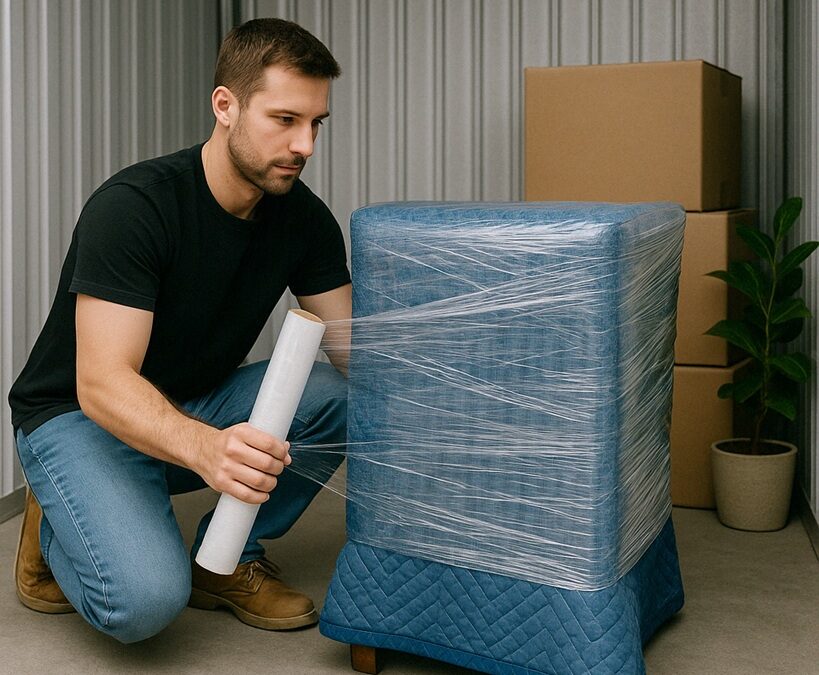Storing furniture can be the perfect solution when you need extra space during a move, renovation, or decluttering project. However, without the proper precautions, your cherished pieces could be exposed to dust, moisture, or even accidental damage while in storage. Protecting your furniture isn’t just about keeping it clean—it’s about ensuring it stays in pristine condition for as long as it’s stored. Let’s dive into how you can protect your furniture effectively while making the most of your personal storage unit.
Clean and Prepare Furniture Before Storage
The first and most important step is to prepare your furniture properly. Skipping this stage can lead to stains, odours, or even structural damage over time.
- Thorough Cleaning: Dirt and grime may seem harmless, but over time, they can lead to permanent stains or attract pests. Give each piece a good clean. For wooden furniture, use a gentle cleaner or polish, and for upholstered items, ensure they’re vacuumed and free from dust.
- Disassemble Large Pieces: Furniture like bed frames, tables, or wardrobes often have removable parts. Disassembling these items not only saves space but also reduces the risk of breakage during transit or storage.
- Inspect and Repair: Take time to check for loose screws, scratches, or weakened joints. Addressing these issues before storage ensures your furniture remains in great condition when it’s time to use it again.
A relatable example: Imagine storing a dining table. By removing the legs and wrapping them separately, you prevent stress on the joints and make it easier to stack other items securely.
Use Protective Covers and Materials
Once your furniture is clean and prepped, it’s time to shield it from dust, scratches, and environmental damage.
- Choose the Right Covers: For upholstered items, breathable dust sheets or fabric covers work best. Avoid plastic wrapping for long-term storage, as it can trap moisture and lead to mildew. For wooden furniture, furniture blankets or padded covers provide excellent protection.
- Corner and Edge Protection: Sharp edges and corners are particularly vulnerable to damage during storage or transit. Foam padding or corner protectors can prevent dents and scratches.
- High-Quality Packaging Supplies: Investing in durable packaging materials ensures your furniture stays safe throughout its storage period.
We offer a range of packaging supplies designed to make furniture protection simple and effective. You can explore these resources here.
Maximise Space While Avoiding Overcrowding
The way you arrange your furniture in the storage unit can make all the difference in keeping it safe.
- Leave Breathing Room: Space between items improves air circulation and prevents accidental knocks or scratches.
- Store Vertically: When possible, store large pieces like sofas or mattresses upright to save floor space, but make sure they’re stable and supported to avoid tipping.
- Stable Stacking: If stacking smaller items on top of larger ones, ensure everything is secure. Heavy items should always go on the bottom, with lighter and more fragile pieces on top.
By organising your storage unit thoughtfully, you’ll not only protect your furniture but also make accessing your belongings much easier.
Protect Furniture from Environmental Factors
Environmental risks, such as moisture and temperature fluctuations, can cause serious damage to furniture if not addressed.
- Use Climate-Controlled Storage for Sensitive Items: Wooden, leather, or antique furniture is particularly vulnerable to changes in temperature or humidity. Climate-controlled storage maintains consistent conditions, preventing cracking, warping, or mould growth.
- Elevate Furniture Off the Floor: Placing items on pallets or boards helps protect them from any unexpected moisture or flooding.
- Add Moisture Absorbers: Using silica gel packets or dehumidifiers within your unit can help control humidity levels and keep mould at bay.
To learn more about climate-controlled options, explore our personal storage solutions here.
Regularly Check and Maintain Stored Furniture
Even with the best precautions, it’s a good idea to check on your furniture periodically.
- Routine Inspections: Every few months, take a look at your storage unit to ensure everything is in good condition. Check for signs of pests, moisture, or shifting items.
- Adjust Covers as Needed: Dust sheets or covers may loosen over time, so ensure they’re still providing proper protection.
- Reorganise When Necessary: If you add or remove items, take time to reconfigure the layout to keep everything stable and secure.
By staying proactive, you can catch and resolve potential issues before they become serious.
Why Newbury Self Store is the Perfect Choice for Furniture Storage
At Newbury Self Store, we understand how important your furniture is—whether it’s a valuable antique or a practical everyday item. That’s why our storage solutions are designed with flexibility, security, and peace of mind in mind.
- Secure Facilities: With 24/7 CCTV and secure access, your belongings are always protected.
- Flexible Storage Options: Whether you’re storing a single chair or an entire room, we have the right size for your needs.
- Expert Advice and Supplies: From packaging materials to storage tips, we’re here to help you every step of the way.
Explore our personal storage options here or get in touch with our team to discuss your specific needs through the contact page.
Protect Your Furniture with Confidence
Taking the time to clean, cover, and arrange your furniture properly ensures it stays in great shape, no matter how long it’s in storage. By addressing environmental risks and checking in periodically, you can store your pieces with confidence, knowing they’ll be ready to use when you need them.
Whether you’re decluttering, renovating, or relocating, our secure personal storage solutions provide the perfect environment for your furniture. Let us help you keep your belongings safe, organized, and ready for the future.


